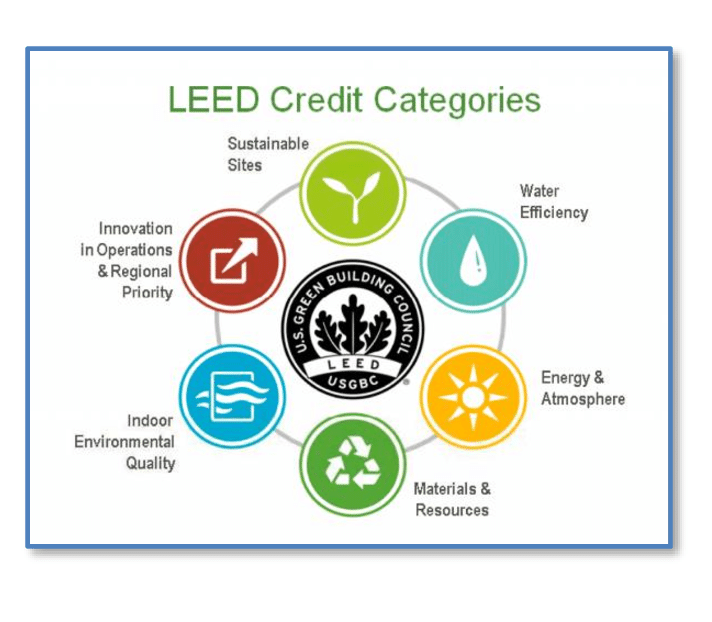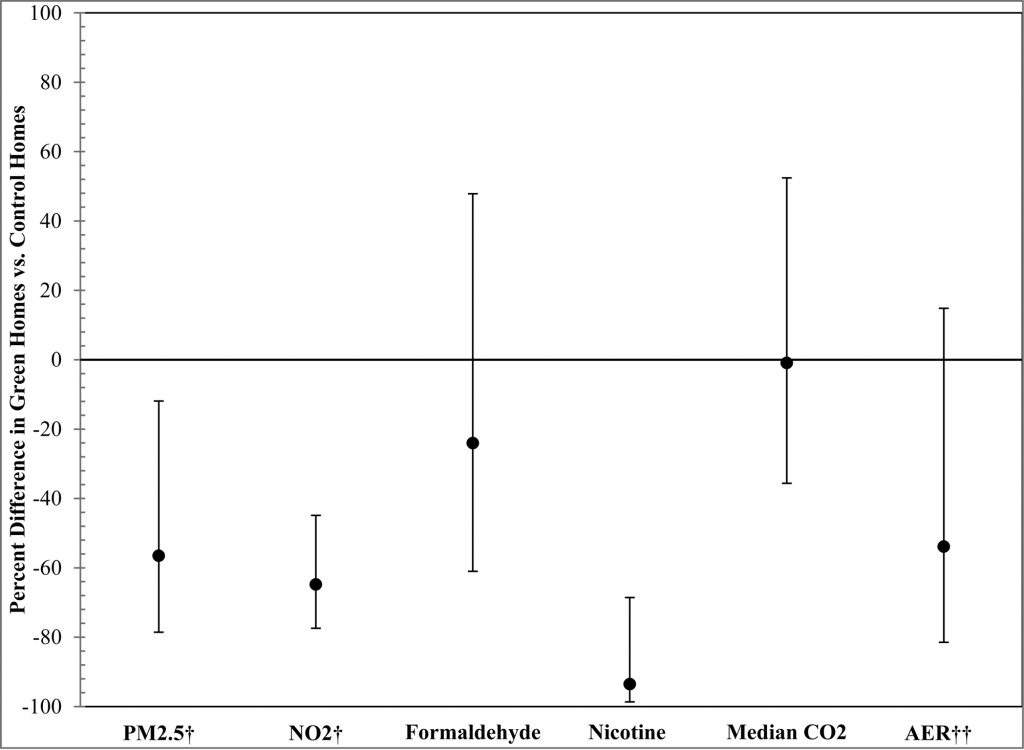The building sector has the greatest potential for greenhouse gas emission reductions compared to other major emitting sectors [1]. It could achieve energy savings of 50% by 2050, in order to limit the global temperature increase to 2°C [2]. This is why many green buildings are being developed today.
We chose this subject because environmental issues are part of our learning process as future civil engineers. We learn how to reduce emissions at every stage of the construction process. At first glance, green buildings look great. But we also need to think about the people who live in them. Taking care of their comfort is part of our future profession, and it’s interesting to qualify our point of view and consider the potential drawbacks of green buildings for IAQ and thermal comfort. Our research is based on the internet, in particular Google scholar which provides relevant studies.
The World Green Building Council defines green buildings as ones that, from an energy standpoint, use resources efficiently and prioritize renewable energy. Furthermore, from a waste management standpoint, buildings that take pollution and waste reduction measures, and use materials that are non-toxic, ethical and sustainable. Green buildings also should have good indoor environmental air quality, take into consideration the environment as well as the quality of life of the occupants whether in its design, construction and operation. Finally, they are designed so they can adapt to a changing thermal environment.
There are different certifications, the main one is LEED (Leadership in Energy and Environmental Design) and is based on 9 criteria (water, energy efficiency, indoor quality…), and each one counts for a certain number of points (Figure 1). In total there are 110 points, and for a building to be certified it must have at least 40 points. However, there are no constraints in the distribution of these points. For example, if you get the 35 points for energy and the 6 points for innovation and design, you get the certification [3].

Source : https://nzehomes.com/index.php/2018/09/06/leed-certification/
These innovative buildings seem to represent a turning point in the construction industry. However, do they really have better indoor air quality and thermal comfort as they claim?
Indoor air pollution is among the top 10 causes of mortality, which is why it is interesting to see if green buildings have better IAQ. As far as air quality is concerned, studies seem to agree: the air in green buildings contains fewer bad particles than in standard buildings [4, 5, 6, 7]. Indeed, green buildings take many measures to try to have good air quality, such as avoiding paints with high VOCs, doing solvent-free finishes, avoiding wood products that contain formaldehyde etc. [8]. Concretely, the NO2 concentration would be reduced by 65% and PM2.5 particles by 57% (Figure 2) [5]. However, even in standard buildings, the regulations seem to be respected [4]. Actually, some aspects of the construction of green buildings can sometimes have negative effects on air quality. Typically, fly ash added to recycled building materials would increase occupant exposure to certain heavy metals that can be toxic [9]. Another issue would be natural ventilation (promoted by LEED). While it requires very little energy, it can increase indoor and outdoor ozone and particulate levels [10]. Finally, let us not forget that a building, whether it is green or not, will not eliminate pollution caused by the occupants’ activities (smoking, use of chemical products).

Source : [5]
When we express our satisfaction or dissatisfaction with a building, it often is because of the thermal comfort. In fact, people tend to notice changes in temperature or humidity much more than poor air quality. The thermal comfort of a building influences the well-being of its occupants, but it also impacts their productivity. However, thermal comfort is subjective and therefore very difficult to control so that everyone is satisfied. Some say that “the well-being and comfort of the occupant may be in conflict with the performance of the building” [11]. Certifications for green buildings generally consider thermal comfort, so these buildings are supposed to have a suitable temperature and air velocity [12]. In a study [12] that compares satisfaction with thermal comfort in conventional and sustainable buildings, results show that most people are more satisfied in green buildings. If we consider the temperature: on a scale of 7, we get 4.41 in green buildings and 3.75 in the standards and for the air rate 4.38 versus 3.75. Another study showed that there was “no difference between building types on the temperatures measured… However, green buildings showed lower air velocities. […] occupants in green buildings […] were less likely to prefer a change in thermal conditions…”. In addition, workers in green, well-ventilated offices record a 26.4% increase in cognitive scores [13]. This means that, on average, people are more satisfied with thermal comfort in green buildings. However, the difference with ordinary buildings is small, so there is room for improvement.
Given all the issues mentioned before, some measures could be taken to improve the situation. In a general way, we could impose more strict indoor climate requirements to get LEED certification. As the world’s most widely used certification for green buildings, the impact on new buildings would be enormous. The second main problem we found is that green materials that are added to buildings (such as fly ash) can have a negative impact on the health of the occupants without the occupants even feeling it since they are mostly odorless. A simple solution would be not to use these types of products in buildings where people may be exposed to them, and more generally to use other types of recycled materials that are harmless, such as pozzolans [14]. The last major issue is the consequences of natural ventilation in green buildings, which can increase the levels of bad particles. This problem can easily be solved by adding mixed-mode ventilation to promote air circulation in the building and reduce high levels of ozone and bad particles [15].
To conclude, the main problem is that green buildings do not prioritize indoor climate. Current certifications are not very restrictive regarding indoor air quality and thermal comfort. In fact, having a certification does not guarantee much in terms of indoor climate. However, overall indoor air quality is often better in green buildings than in most normal buildings. The solution may therefore lie in stricter certifications that could make it possible to have buildings that are not only more respectful of the planet but also of the well-being and health of their occupants.
Arthur Carmès, Héloïse Marquès, Anouck Blouin & Salomé Hess
REFERENCES
[1] UNEP (2009) Sustainable Buildings & Climate Initiative. P.9. Retrieved 13 November 2020
[2] Dean, B., Dulac, J., Petrichenko, K., & Graham, P. (2016). Towards zero-emission efficient and resilient buildings. Global Status Report. Global Alliance for Buildings and Construction (GABC)
[3] World Green Building Council. Retrieved 16 November 2020
[4] Newsham G. et al. (2013) Do ‘green’ buildings have better indoor environments? New evidence, Building Research & Information, 41:4, 415-434, DOI: 10.1080/09613218.2013.789951
[5] Colton MD. et al. (2014) Indoor air quality in green vs conventional multifamily low-income housing. Environ Sci Technol. 15;48(14):7833-41. doi: 10.1021/es501489u. Epub 2014 Jul 1. PMID: 24941256.
[6] Cassandra L. et al. (2014) Building design and performance: A comparative longitudinal assessment of a Children’s hospital, Building and Environment (2014), Volume 7al8, Pages 130-136, ISSN 0360-1323
[7] Abbaszadeh, S., Zagreus, L., Lehrer, D., & Huizenga, C. (2006). Occupant satisfaction with indoor environmental quality in green buildings. UC Berkeley: Center for the Built Environment.
[8] Indoor air quality. (2017) http://www.greenbuilding.com/indoor-air-quality/, Retrieved 23 November 2020
[9] Anne Steinemann, Pawel Wargocki, Behzad Rismanchi, (2017), Ten questions concerning green buildings and indoor air quality, Building and Environment (2017), Volume 112, Pages 351-358, ISSN 0360-1323
[10] Dutton, Spencer & Banks, David & Brunswick, Samuel & Fisk, William. (2013). Health and economic implications of natural ventilation in California offices. Building and Environment. 67. 34–45. 10.1016/j.buildenv.2013.05.002.
[11] Yousef Al horr et al. (2016), Impact of indoor environmental quality on occupant well-being and comfort: A review of the literature, International Journal of Sustainable Built Environment, Volume 5, Issue 1, 2016, Pages 1-11. 2212-6090, Retrieved 11 November 2020
[12] George Baird, Carmeny Field, (2013) Thermal comfort conditions in sustainable buildings – Results of a worldwide survey of users’ perceptions, Renewable Energy (2013), Volume 49, Pages 44-47, ISSN 0960-1481
[13] Piers MacNaughton et al. (2017) The impact of working in a green certified building on cognitive function and health,
Building and Environment (2017), Volume 114, Pages 178-186, ISSN 0360-1323
[14] Prof. Karen Scrivener. (2020). Materials course BA2. Retrieved 4. November 2020
[15] Prof. Dusan Licina. (2020). Fundamentals of indoor climate BA3. Retrieved 12. November 2020
[1] UNEP (2009) Sustainable Buildings & Climate Initiative. P.9. Retrieved 13 November 2020
[2] Dean, B., Dulac, J., Petrichenko, K., & Graham, P. (2016). Towards zero-emission efficient and resilient buildings. Global Status Report. Global Alliance for Buildings and Construction (GABC)
[3] World Green Building Council. Retrieved 16 November 2020
[4] Newsham G. et al. (2013) Do ‘green’ buildings have better indoor environments? New evidence, Building Research & Information, 41:4, 415-434, DOI: 10.1080/09613218.2013.789951
[5] Colton MD. et al. (2014) Indoor air quality in green vs conventional multifamily low-income housing. Environ Sci Technol. 15;48(14):7833-41. doi: 10.1021/es501489u. Epub 2014 Jul 1. PMID: 24941256.
[6] Cassandra L. et al. (2014) Building design and performance: A comparative longitudinal assessment of a Children’s hospital, Building and Environment (2014), Volume 7al8, Pages 130-136, ISSN 0360-1323
[7] Abbaszadeh, S., Zagreus, L., Lehrer, D., & Huizenga, C. (2006). Occupant satisfaction with indoor environmental quality in green buildings. UC Berkeley: Center for the Built Environment.
[8] Indoor air quality. (2017) http://www.greenbuilding.com/indoor-air-quality/, Retrieved 23 November 2020
[9] Anne Steinemann, Pawel Wargocki, Behzad Rismanchi, (2017), Ten questions concerning green buildings and indoor air quality, Building and Environment (2017), Volume 112, Pages 351-358, ISSN 0360-1323
[10] Dutton, Spencer & Banks, David & Brunswick, Samuel & Fisk, William. (2013). Health and economic implications of natural ventilation in California offices. Building and Environment. 67. 34–45. 10.1016/j.buildenv.2013.05.002.
[11] Yousef Al horr et al. (2016), Impact of indoor environmental quality on occupant well-being and comfort: A review of the literature, International Journal of Sustainable Built Environment, Volume 5, Issue 1, 2016, Pages 1-11. 2212-6090, Retrieved 11 November 2020
[12] George Baird, Carmeny Field, (2013) Thermal comfort conditions in sustainable buildings – Results of a worldwide survey of users’ perceptions, Renewable Energy (2013), Volume 49, Pages 44-47, ISSN 0960-1481
[13] Piers MacNaughton et al. (2017) The impact of working in a green certified building on cognitive function and health,
Building and Environment (2017), Volume 114, Pages 178-186, ISSN 0360-1323
[14] Prof. Karen Scrivener. (2020). Materials course BA2. Retrieved 4. November 2020
[15] Prof. Dusan Licina. (2020). Fundamentals of indoor climate BA3. Retrieved 12. November 2020